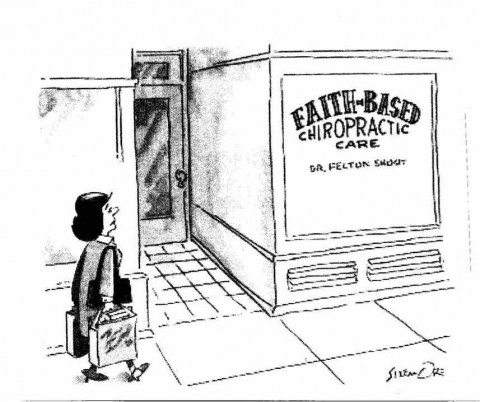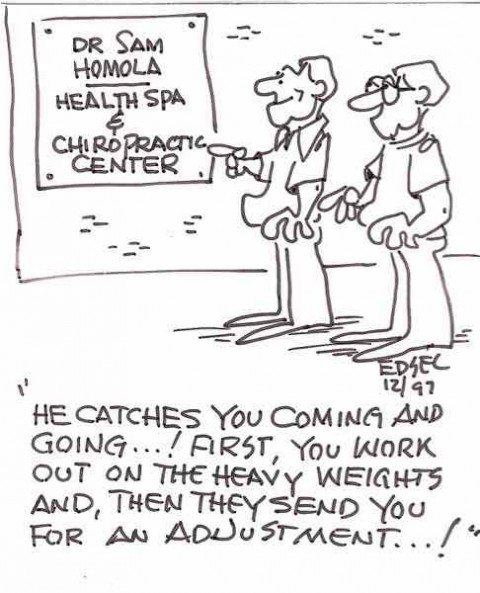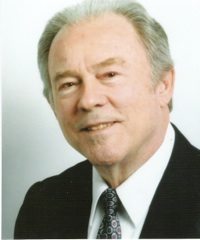
Subluxation-based chiropractic care is sustained more by faith than by facts
Much of what is discussed in this article has been said before in previous articles I have written for Science-Based Medicine. But since the audience for SBM has greatly increased over the past few years, some subject matter should be repeated for the new readers and researchers coming to this site for reliable information on health care.
Many consumers now search SBM for articles dealing with controversial alternative treatment methods that have been shown to be ineffective or to be loaded with fraud and quackery. Chiropractic in particular continues to be problematic for its failure to renounce the scientifically indefensible, nonfalsifiable subluxation theory that defines the profession as a whole. A review of chiropractic web sites reveals that many chiropractors continue to base their treatment methods on subluxation theory, encompassing a broad scope of health problems. Some chiropractors are now including use of “functional medicine” which uses “natural tools” to treat diabetes, thyroid disease, neuropathy, and other diseases best treated by conventional medical care. Most alarming of all is the treatment of infants and children by “pediatric chiropractors.” Chiropractors are being certified in 10 different specialties, including a diplomate in Diagnosis and Internal Disorders.
As long as chiropractic is licensed as a health-care profession based on subluxation theory or some other unscientific approach, it will continue to be subjected to scrutiny and criticism by the science-based community. It is, in fact, the moral and ethical responsibility of science-based practitioners to oppose any form of unscientific health care, wherever it might exist, separating sense from nonsense without being influenced by politics, special interest, pseudoscience, or belief systems.
Legal recognition vs. science
The vertebral subluxation theory that defines the chiropractic profession has been rejected by the scientific community. Yet, chiropractic has gained public acceptance and licensure as a profession capable of treating both physical and organic ailments. Some chiropractors claim to be primary care providers, despite use of a limited treatment method. Chiropractic’s primary treatment, the spinal adjustment, is described as a modality used to improve health by correcting vertebral subluxations that are interfering with nerve supply to the body’s organs. While spinal manipulation might have value as a complementary procedure or as a treatment option in the care of mechanical-type neck and back problems, a distinction should be made between appropriate use of generic spinal manipulation and the questionable use of chiropractic adjustments to restore and maintain health.
Legal recognition of chiropractic as a health-care profession has generated considerable confusion in the public’s perception of the role of manual therapy in health care. Subluxation theory defining use of manipulation by chiropractors has allowed the proliferation of practitioners who promote a variety of nonsensical treatment methods that are the antithesis of generally accepted medical care. Separated from the mainstream of health care, chiropractic is being presented as a form of alternative medicine, competing with primary care physicians as well as with physical therapists who offer manual therapy for musculoskeletal problems. In the absence of any apparent movement by the chiropractic profession to police its ranks, it is important that the general public be made aware of the controversy surrounding subluxation-based chiropractic care.
The implausibility of subluxation theory
There is no credible evidence to support the contention that a vertebral subluxation, a joint dysfunction, or compression of a spinal nerve can cause nerve interference that will affect general health or cause organic disease.1,2 A simple review of anatomy and the nervous system seems to provide enough evidence to refute subluxation theory.
Spinal nerves are commonly compressed by bony spurs and herniated discs. Compression of a spinal nerve can cripple supplied musculoskeletal structures but does not cause organic disease. In the absence of pathology such as disc herniation or osteophyte formation, vertebral misalignments rarely affect spinal nerves. The body’s organs are supplied primarily by autonomic nerve ganglia and plexuses located outside the spinal column and by autonomic cranial and sacral nerves that pass through solid bony openings,3 providing overlapping nerve supply that is unaffected by slight misalignment of a vertebra or by a dysfunctional spinal segment.
Defining chiropractic
The chiropractic profession continues to cling to the theory that gave it birth and independence. State laws defining chiropractic as a method of restoring and maintaining health by adjusting vertebral subluxations to remove nerve interference remain unchallenged.4
According to a 2015 publication by the National Board of Chiropractic Examiners in the United States:
The specific focus of chiropractic practice is known as the chiropractic subluxation or joint dysfunction. A subluxation is a health concern that manifests in the skeletal joints, and through complex anatomical and physiological relationships, affects the nervous system and may lead to reduced function, disability, or illness.5
Some definitions of chiropractic avoid use of the word “subluxation,” referring instead to nerve interference as a cause of disease. Such interference is often attributed to a “vertebral subluxation complex” involving changes in nerve, muscle, connective tissue, and vascular tissues without actual displacement of a vertebra.6 Although chiropractic subluxation theory has evolved from a bone-on-a-nerve theory to a more complex description involving “a complex of functional and/or structural and/or pathological articular changes that compromise neural integrity and may influence organ system function and general health,” 7 the theory is no less implausible. An asymptomatic chiropractic subluxation alleged to be a cause of disease (not to be confused with a real orthopedic subluxation that causes musculoskeletal symptoms) is generally considered to be an imaginary lesion.
It is important to remember that subluxation-based chiropractors often genuinely believe that they can restore and maintain health by adjusting the spine and will often advise their back-pain patients that every member of the family needs regular spinal adjustments to stay healthy. For this reason, physicians and science-based chiropractors should openly advise against subluxation-based chiropractic care, especially when recommending chiropractic care for back pain. Unfortunately, chiropractic associations might be reluctant to renounce the nerve interference aspect of subluxation theory, which would require a change in legislation that supports the licensure and livelihood of thousands of chiropractors.
If the mission of chiropractic colleges is not changed sufficiently to produce a chiropractic majority that opposes subluxation theory, laws and the belief system defining the practice of chiropractic will not change.
Appropriate use of spinal manipulation
Systematic reviews of the literature on the use of manipulation in the treatment of back pain indicate that spinal manipulative therapy may not be any more effective than other recommended therapies.8,9 A 2012 systematic review of the effectiveness of spinal manipulation provided by physical therapists in the treatment of low back pain concluded: “Based on the findings of this systematic review there is evidence to support the use of spinal manipulation by physical therapists in clinical practice. Physical therapy spinal manipulation appears to be a safe intervention that improves clinical outcomes for patients with low back pain.”10
I suspect that future research will identify specific mechanical-type back problems for which judicious use of spinal manipulation might be the treatment of choice in relieving pain and restoring mobility. Some back-pain patients simply prefer the pleasurable, relaxing effects of hands-on manipulation and massage. Patient satisfaction coupled with the immediate, albeit temporary, effects of spinal manipulation is reason enough to support inclusion of spinal manipulative therapy as complementary care or as a treatment option in the physical treatment armamentarium of any therapist or practitioner who treats back pain — without subluxation theory, of course.
Unfortunately, the Chiropractic Paradigm of the Association of Chiropractic Colleges, which “focuses particular attention on the subluxation,”7 is echoed in a 2015 survey of North American chiropractic students, “a majority of whom would like to see an emphasis on correction of vertebral subluxations.”11 Regardless of scientific developments in the use of spinal manipulation, it appears that subluxation-based chiropractic will be perpetuated as a belief system.

Back-care specialty, an opportunity missed
While opinions describing chiropractic range from “quackery” to “miracle healing,” many people think of chiropractors as back doctors since they manipulate the spine for what is commonly believed to be a vertebra out of place. A 2015 Gallup poll (“Americans’ Perceptions of Chiropractic“) reported that the majority (61%) of American adults agree that chiropractors are effective at treating neck and back pain.
“When given a choice of five different healthcare providers they might see about neck and back pain, regardless of cost, slightly more than half of adults (54%) say a medical doctor would be their first choice, followed by 29% saying they would most like to see a chiropractor. Less than 10% would prefer to see a physical therapist, massage therapist or acupuncturist for neck or back pain.”12 Although a majority agreed that chiropractic is an effective treatment for neck and back pain, only 29% of polled respondents would choose chiropractic for such care, perhaps reflecting low confidence in treatment provided by chiropractors.
Despite the public’s perception that chiropractors treat neck and back pain, and the fact that back pain and musculoskeletal problems are the No. 1 and No. 2 causes of disability worldwide,13 chiropractic has failed to fill a niche as a specialty providing conservative care for mechanical-type back pain. There are some good chiropractors who use generic manipulation appropriately in a practice limited to care of back pain and related musculoskeletal problems, and they can offer a service of value. It appears, however, that the chiropractic profession as a whole may have missed an opportunity to abandon subluxation theory and make the changes needed to become a legitimate mainstream musculoskeletal back-care specialty based on science, the common denominator that unites mainstream health-care professionals. An increasing number of physical therapists are now being trained in the use of science-based spinal manipulation, offering an alternative to subluxation-based chiropractic manipulation.
Some chiropractors identify themselves as spine specialists, a designation often used by orthopedists who have the facilities and the means to handle any kind of spine problem. Since chiropractors cannot offer medication to relieve acute back pain and do not have access to the hospital facilities needed to treat a serious, incapacitating back injury or to diagnose back pain of unknown origin, chiropractic care cannot always be appropriate for back pain or a spine problem. A science-based chiropractor who offers conservative care for uncomplicated back pain would be compelled to refer certain acute back-pain patients to medical providers for pain relief, for hospitalization, or for a hospital-based diagnostic procedure. A correct diagnosis indicating disease, infection, or neurological complications would require immediate referral to a medical specialist.
A chiropractic “spine specialist,” subluxation-based or not, is obviously not capable of independently handling back pain across the board. No specialty can function in the best interest of the patient without the cooperation of mainstream health-care professionals, a position unattainable by chiropractic in its present form.
Chiropractic specialties vs. medical specialties
Despite the limitations of chiropractic treatment methods and the isolation of chiropractic from mainstream health care, the American Chiropractic Association (ACA) endorses 10 post-graduate programs offering diplomate certification in specialties for chiropractors:
- Chiropractic Pediatrics
- Chiropractic Physical and Therapeutic Rehabilitation
- Chiropractic Acupuncture
- Diagnosis and Internal Disorders
- Diagnostic Imaging
- Neurology
- Nutrition
- Occupational Health
- Sports Physician
- Orthopedics
With the exception of Diagnostic Imaging, which requires a full-time 3-year residency in a chiropractic college, certification in these specialties is obtained by attending 300 to 400 hours of classroom instruction in 26 sessions of 12-hour weekends over a period of 3 years.14 Such part-time classroom instruction cannot begin to compare with a full-time residency program in a hospital setting that lasts 3 to 7 years after graduation from medical school, depending upon the specialty. An additional 1 to 3 years of training is required for a subspecialty.15
Resisting what the chiropractic profession considers to be a demeaning identification as a back specialty, it appears that the profession has taken the untenable position of competing with medical specialties, using spinal adjustments as the primary treatment method. According to an executive of the ACA’s Council on Diagnosis and Internal Disorders, a chiropractic internist with a DABCI certification (Diplomate American Board of Chiropractic Internists) can treat everything from allergies to thyroid problems to fatigue as a primary care physician:
We do laboratory workups, blood chemistries, adrenal and hormone testing, GI function studies, EKGs. We treat everything from allergies to thyroid problems to fatigue. It makes us more of a family doctor, not in the sense that we always take care of the whole family, but we can take care of all that ails them….If I’m adjusting somebody and not getting them better, [my training] gives me a broader range of things to look at as to what it might be.14
While post-graduate study offered to chiropractors is commendable for its value in expanding the knowledge base of the individual practitioner, specialty certification in a chiropractic classroom cannot compare or compete with a board-certified hospital-based medical specialty that requires thousands of hours of training. A chiropractic specialty certainly does not justify or excuse use of chiropractic adjustments based on vertebral subluxation theory, and it is no less questionable under the label of alternative medicine or integrative medicine.
State laws defining chiropractic as a method of adjusting vertebral subluxations do not permit chiropractors to use many of the tests and procedures implied to be part of a chiropractic specialty. Medicare coverage of chiropractic services, defined by federal law, is specifically limited to manual manipulation of the spine to correct a subluxation (demonstrated to exist) causing a related neuromusculoskeletal problem; no other diagnostic or therapeutic service furnished by a chiropractor or under the chiropractor’s order is covered.
As we men of medicine grow in learning we more justly appreciate our dependence upon each other. It has become necessary to develop medicine as a cooperative science, the clinician, the specialist and the laboratory workers uniting for the good of the patient. The people will demand, the medical profession must supply, adequate means for the proper care of patients, which means that individualism in medicine can no longer exist.16
Dr. Will Mayo (1861-1939)
References
- The College of Physicians and Surgeons of Quebec. The Scientific Brief Against Chiropractic. The New Physician. 1966. http://www.chirobase.org/05RB/CPSQ/00.html. (Accessed August 19, 2015)
- Mirtz, TA, Morgan L, Wyatt LH, Greene L. 2009. An epidemiological examination of the subluxation construct using Hill s criteria of causation. Chiropr Man Therap. 17:13. http://www.ncbi.nlm.nih.gov/pubmed/19954544 (Accessed August 30, 2015)
- Homola S. Chiropractic: History and Overview of Theories and Methods. Clin Orthop Relat Res. 2006. 444:236-242.
- Bellamy JJ. Legislative alchemy: The U.S. state chiropractic practice acts. Focus Alternat Complement Ther. 2010 Sept;15(3):214-222.
- Christensen MG, Hyland JK, Goertz CM, Kollasch MW, Shotts BL, Blumlein NL, et al. Practice Analysis of Chiropractic 2015. National Board of Chiropractic Examiners. Greeley, Colorado. May 2015. p5. http://www.nbce.org/practiceanalysis/ (Accessed September 21, 2015)
- Rosner AL. The Role of Subluxation in Chiropractic. 1997. Foundation for Chiropractic Education and Research. p2
- Association of Chiropractic Colleges. Chiropractic Paradigm. http://www.chirocolleges.org/paradigmscopepractice.html. (Accessed August 30, 2015)
- Rubinstein SM, van Middelkoop M, Assendelft WJ, de Boer MR, van Tulder MW. Spinal manipulative therapy for chronic low-back pain: an update of a Cochrane review. Spine. 2011; 36(13):E825-46. http://www.ncbi.nlm.nih.gov/pubmed/21593658 (Accessed September 21, 2015)
- Rubinstein SM, Terwee CB, Assendelft WJ, de Boer MR, van Tulder MW. Spinal manipulative therapy for acute low back pain: an update of the Cochrane review. Spine. 2013; 38(3):E158-77.
- Kuczynski JJ, Schwieterman B, Columber K, Knupp D, Shaub L, Cook CE. Effectiveness of physical therapist administered spinal manipulation for the treatment of low back pain: a systematic review of the literature. Int J Sports Ther. 2012;7(6):647-662. http://www.ncbi.nlm.nih.gov/pmc/articles/PMC3537457/ (Accessed September 21, 2015)
- Gliedt JA, Hawk C, Anderson M, Ahmad K, Bunn D, Cambron J, et al. Chiropractic identity, role and future: a survey of North American chiropractic students. Chiropr Man Therap. 2015;23.4. http://www.chiromt.com/content/23/1/4 (Accessed August 30, 2015).
- English C, Keating E. Majority in U.S. say chiropractic works for neck, back pain. Gallup. September 8, 2016. http://www.gallup.com/poll/184910/majority-say-chiropractic-works-neck-back-pain.aspx? (Accessed September 8, 2015).
- Vos T, Flaxman AD, Naghavi M, Lozano R, Michaud C, Ezzati M, et al. Years lived with disability (YLDs) for 1160 sequelae of 289 diseases and injuries 1990-2010: a systematic analysis for the Global Burden of Disease Study 2010. Lancet. 2012; 15;380(9859):2163-96.
- American Chiropractic Association. Chiropractic Specialties on the Rise. https://www.acatoday.org/content_css.cfm?CID=2323 (Accessed August 28, 2015).
- American Medical Association. Requirements for Becoming a Physician. http://www.ama-assn.org/ama/pub/education-careers/becoming-physician.page? (Accessed August 30, 2015).
- Clapesattle, Helen. The Doctors Mayo. Garden City Publishing Company. Garden City, New York, 1943.

Sam Homola is a retired chiropractor who has been expressing his views about the benefits of appropriate use of spinal manipulation (as opposed to use of such treatment based on chiropractic subluxation theory) since publication of his book Bonesetting, Chiropractic, and Cultism in 1963. He retired from private practice in 1998. His many posts for ScienceBasedMedicine.org are archived here.
